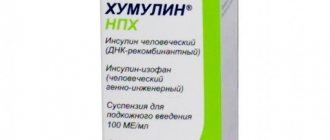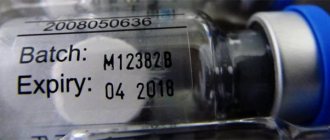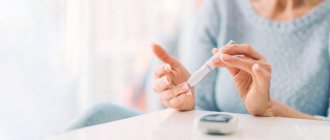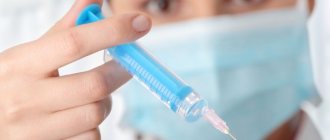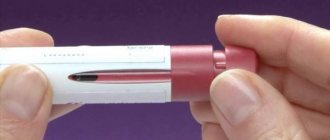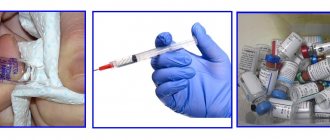Analogues of the drug according to ATC codes:
GENSULIN N INSUMAN BAZAL GT PROTAFAN NM PROTAFAN NM PENFYLL RINSULIN NPH HUMODAR B 100 HUMULIN NPH All
Before using the drug BIOSULIN N, you should consult your doctor. These instructions for use are for informational purposes only. For more complete information, please refer to the manufacturer's instructions.
Release form, composition and packaging
Suspension for subcutaneous injection, white; when standing, the suspension settles, forming a white precipitate. The supernatant liquid is clear, colorless or almost colorless. The sediment is easily resuspended with gentle shaking.
| 1 ml | |
| insulin isophane (human genetically engineered) | 100 IU |
Excipients: zinc oxide, sodium hydrogen phosphate, protamine sulfate, metacresol, crystalline phenol, glycerol, water for injection.
3 ml - colorless glass cartridges for use with a BiomaticPen® or Biosulin® Pen syringe pen (1) - blister contour packaging (1) - packs. 3 ml - colorless glass cartridges for use with a BiomaticPen® or Biosulin® Pen syringe pen ( 3) - contour cell packaging (1) - packs. 3 ml - colorless glass cartridges for use with the BiomaticPen® or Biosulin® Pen syringe pen (5) - contour cell packaging (1) - packs.
Suspension for subcutaneous injection, white; when standing, the suspension settles, forming a white precipitate. The supernatant liquid is clear, colorless or almost colorless. The sediment is easily resuspended with gentle shaking.
| 1 ml | |
| insulin isophane (human genetically engineered) | 100 IU |
Excipients: zinc oxide, sodium hydrogen phosphate, protamine sulfate, metacresol, crystalline phenol, glycerol, water for injection.
5 ml - colorless glass bottles (1) - packs. 5 ml - clear glass bottles (2) - contour cell packaging (1) - packs. 5 ml - colorless glass bottles (3) - contour cell packaging (1) - packs. 5 ml - colorless glass bottles (5) - contour cell packaging (1) - packs. 10 ml - colorless glass bottles (1) - packs. 10 ml - colorless glass bottles (2) - contour cell packaging (1) - packs. 10 ml - colorless glass bottles (3) - contour cell packaging (1) - packs. 10 ml - colorless glass bottles (5) - contour cell packaging (1) - packs.
Biosulin price, where to buy
You can buy Biosulin N at any pharmacy. The cost of 1 bottle of suspension 100 IU 10 ml is 500-510 rubles, 5 cartridges of 3 ml each can be purchased for 1046-1158 rubles.
- Online pharmacies in RussiaRussia
ZdravCity
- Biosulin n suspension.
for s/c input. 100 IU/ml 3ml No. 5 (cartridge + syringe pen) Pharmstandard-Ufavita Ufimsky vitamin plant OJSC RUB 1,464 order - Biosulin R solution for in. 100 IU/ml 3ml 5 pcs Pharmstandard-Ufavita Ufimsky vitamin plant OJSC
RUB 1,096 order
- Biosulin N suspension. for s/c input. 100 IU/ml 3ml 5 pcs Pharmstandard-Ufavita Ufimsky vitamin plant OJSC
RUB 1,113 order
- Biosulin R solution for in. 100 IU/ml 10mlPharmstandard-Ufavita Ufa vitamin plant OJSC
RUR 515 order
pharmachologic effect
Medium-acting insulin preparation. It is human insulin obtained using recombinant DNA technology.
Interacts with a specific receptor on the outer cytoplasmic membrane of cells and forms an insulin-receptor complex that stimulates intracellular processes, incl. synthesis of a number of key enzymes (including hexokinase, pyruvate kinase, glycogen synthetase). The decrease in blood glucose levels is due to an increase in its intracellular transport, increased absorption and assimilation by tissues, stimulation of lipogenesis, glycogenogenesis, and a decrease in the rate of glucose production by the liver.
The duration of action of insulin preparations is mainly determined by the rate of absorption, which depends on several factors (for example, on the dose, route and site of administration), and therefore the insulin action profile is subject to significant fluctuations, both between different and within the same patient .
After subcutaneous administration, the onset of action is observed after approximately 1-2 hours, the maximum effect is between 6 and 12 hours, the duration of action is 18-24 hours.
Reviews about Biosulin
The drug of choice in the treatment of patients with diabetes is genetically engineered human insulin, which is identical in chemical structure to human insulin. According to the International Diabetes Federation, these are the only insulins used throughout the world. Their advantage is their effectiveness and safety, and therefore the Ministry of Health of the Russian Federation recommends their use for the treatment of adolescents, children and pregnant women. The results of studies of such drugs showed that the content of liver enzymes, lipids, residual nitrogen, creatinine and urea remained within normal limits during their use. No one had any allergic reactions.
Another advantage (this applies to the long-acting drug) is that the protein protamine (the so-called NPH insulin ) is used as a prolongator, rather than zinc. NPH insulins can be mixed with short-acting drugs in the same syringe and this will not lead to a change in pharmacokinetics. Despite all the advantages, there are negative reviews and many patients prefer imported drugs ( Humalog , NovoRapid ).
- “... I’ve been injecting him for several months now. Everything is fine, but I think that there is nothing better than Humalog.”
- “... Grandmother on Biosuline. It’s possible to compensate for the sugar, but the vision decreases and the diabetic foot.”
- “... I’ve been on it for several days. Issued at the clinic. It got worse - sugar levels are over 20! Does not help!".
- “...Personally, Biosulin N does not help me, but Biosulin R works well.”
Pharmacokinetics
Suction
The completeness of absorption and the onset of the effect of insulin depends on the injection site (abdomen, thigh, buttocks), dose (volume of insulin administered), and insulin concentration in the drug.
Distribution
Distributed unevenly in tissues. Does not penetrate the placental barrier and is not excreted in breast milk.
Metabolism
It is destroyed by insulinase mainly in the liver and kidneys.
Removal
Excreted in urine - 30-80%.
BIOSULIN N: DOSAGE
The dose of the drug is determined by the doctor individually, in each specific case, based on the level of glucose in the blood.
The drug is intended for subcutaneous administration. The average daily dose varies from 0.5 to 1 IU/kg body weight (depending on the individual characteristics of the patient and blood glucose levels).
The temperature of the administered insulin should be at room temperature.
Biosulin® N is injected subcutaneously into the thigh; injections can also be made into the anterior abdominal wall, buttock or deltoid muscle area.
It is necessary to change injection sites within the anatomical region to prevent the development of lipodystrophies.
Biosulin® N can be administered either as a single drug or in combination with short-acting insulin (Biosulin® R).
Injection technique when using insulin in vials
If the patient is using only one type of insulin
1. The rubber membrane on the bottle should be disinfected.
2. Draw air into the syringe in an amount corresponding to the required dose of insulin. Inject air into the insulin vial.
3. Turn the bottle with the syringe upside down and draw the required dose of insulin into the syringe. Remove the needle from the vial and remove air from the syringe. Check that the insulin dose is set correctly.
4. Inject immediately.
If a patient needs to mix two types of insulin
1. The rubber membranes on the bottles should be disinfected.
2. Immediately before drawing, roll the vial of long-acting insulin (“cloudy”) between your palms until the insulin becomes uniformly white and cloudy.
3. Draw air into the syringe in an amount corresponding to the dose of “cloudy” insulin. Inject air into the bottle with “cloudy” insulin and remove the needle from the bottle (“cloudy” insulin should not be drawn at this stage yet).
4. Draw air into the syringe in an amount corresponding to the dose of short-acting (“transparent”) insulin. Inject air into the vial with “transparent” insulin. Turn the bottle with the syringe upside down and draw the required dose of “transparent” insulin. Remove the needle and remove air from the syringe. Check that the dose taken is correct.
5. Insert the needle into the bottle with “cloudy” insulin, turn the bottle with the syringe upside down and draw the required dose of insulin. Remove air from the syringe and check the correct dose. Immediately inject the collected insulin mixture.
6. Insulins should always be taken in the same sequence described above.
Injection technique when using insulin cartridges
The cartridge with the drug Biosulin® N is intended for use with the BiomaticPen® or Biosulin® Pen syringe pen. The patient should be warned about the need to carefully follow the instructions in the instructions for using the syringe pen for administering insulin.
Before use, make sure that there is no damage (for example, cracks) on the cartridge with Biosulin® N. Do not use the cartridge if there is any visible damage. After the cartridge is inserted into the pen, a colored stripe should be visible through the window of the cartridge holder.
Before placing the cartridge into the pen, you should turn the cartridge up and down so that the glass ball moves from end to end of the cartridge. This procedure should be repeated at least 10 times until all the liquid becomes white and uniformly cloudy. Immediately after this you need to give an injection.
If the cartridge is already inside the pen, you should turn it with the cartridge inside up and down at least 10 times. This procedure must be repeated before each injection.
After injection, the needle should remain under the skin for at least 6 seconds. You should keep the button pressed until the needle is completely removed from under the skin, thus ensuring the correct dose is administered and limiting the possibility of blood or lymph getting into the needle or into the insulin cartridge.
The cartridge with Biosulin® N is intended for individual use only and cannot be refilled.
Injection procedure
1. Use two fingers to gather a fold of skin, then insert a needle into the base of the fold at an angle of about 45° and inject insulin under the skin.
2. After injection, the needle must remain under the skin for at least 6 seconds to ensure that the insulin is completely injected.
3. If after removing the needle there is blood at the injection site, you must press the injection site with your finger.
4. Injection sites should be changed.
Instructions:
Clinical and pharmacological group
15.001 (short-acting human insulin)
Release form, composition and packaging
The solution for injection is colorless or almost colorless, transparent or almost transparent.
| 1 ml | |
| soluble insulin (human genetically engineered) | 100 IU |
Excipients: glycerol, metacresol, hydrochloric acid or sodium hydroxide (10% solution, to maintain pH level), water for injection.
3 ml - colorless glass cartridges for use with a BiomaticPen® or Biosulin® Pen syringe pen (1) - blister contour packaging (1) - packs. 3 ml - colorless glass cartridges for use with a BiomaticPen® or Biosulin® Pen syringe pen ( 3) - contour cell packaging (1) - packs. 3 ml - colorless glass cartridges for use with the BiomaticPen® or Biosulin® Pen syringe pen (5) - contour cell packaging (1) - packs.
The solution for injection is colorless or almost colorless, transparent or almost transparent.
| 1 ml | |
| soluble insulin (human genetically engineered) | 100 IU |
Excipients: glycerol, metacresol, hydrochloric acid or sodium hydroxide (10% solution, to maintain pH level), water for injection.
5 ml - colorless glass bottles (1) - packs. 5 ml - clear glass bottles (2) - contour cell packaging (1) - packs. 5 ml - colorless glass bottles (3) - contour cell packaging (1) - packs. 5 ml - colorless glass bottles (5) - contour cell packaging (1) - packs. 10 ml - colorless glass bottles (1) - packs. 10 ml - colorless glass bottles (2) - contour cell packaging (1) - packs. 10 ml - colorless glass bottles (3) - contour cell packaging (1) - packs. 10 ml - colorless glass bottles (5) - contour cell packaging (1) - packs.
pharmachologic effect
Short-acting insulin. It is human insulin obtained using recombinant DNA technology.
Interacts with a specific receptor on the outer cytoplasmic membrane of cells and forms an insulin-receptor complex that stimulates intracellular processes, incl. synthesis of a number of key enzymes (including hexokinase, pyruvate kinase, glycogen synthetase). The decrease in blood glucose levels is due to an increase in its intracellular transport, increased absorption and assimilation by tissues, stimulation of lipogenesis, glycogenogenesis, and a decrease in the rate of glucose production by the liver.
The duration of action of insulin drugs is mainly determined by the rate of absorption, which depends on several factors (for example, dose, route and site of administration), and therefore the insulin action profile is subject to significant fluctuations, both between different people and within the same person. patient.
After subcutaneous administration, the onset of action of the drug is observed after approximately 30 minutes, the maximum effect is in the interval between 2 and 4 hours, the duration of action is 6-8 hours.
Pharmacokinetics
Suction
The completeness of absorption and the onset of the effect of insulin depends on the method of administration (s.c. or i.m.) and the site of administration (abdomen, thigh, buttocks), dose (volume of insulin administered), and concentration of insulin in the drug.
Distribution
Distributed unevenly in tissues. Does not penetrate the placental barrier and is not excreted in breast milk.
Metabolism
It is destroyed by insulinase mainly in the liver and kidneys.
Removal
T1/2 is several minutes. Excreted in urine - 30-80%.
Dosage
The dose of the drug is determined by the doctor individually, in each specific case, based on the level of glucose in the blood.
The drug is intended for subcutaneous, intramuscular, and intravenous administration.
On average, the daily dose of the drug ranges from 0.5 to 1 IU/kg body weight (depending on the individual characteristics of the patient and blood glucose levels).
The drug is administered 30 minutes before a meal or light snack containing carbohydrates.
The temperature of the administered insulin should be at room temperature.
For monotherapy, the frequency of administration is 3 times a day (if necessary, 5-6 times a day). With a daily dose exceeding 0.6 IU/kg, it must be administered in the form of 2 or more injections into different areas of the body.
Biosulin® R is usually administered subcutaneously into the anterior abdominal wall. Injections can also be given in the thigh, buttock or deltoid muscle area. It is necessary to change injection sites within the anatomical region to prevent the development of lipodystrophy.
Biosulin® R can be administered intramuscularly and intravenously only under the supervision of a physician.
Biosulin® R is a short-acting insulin and is usually used in combination with intermediate-acting insulin (Biosulin® N).
Injection technique when using insulin in vials
If the patient is using only one type of insulin
1. The rubber membrane on the bottle should be disinfected.
2. Draw air into the syringe in an amount corresponding to the required dose of insulin. Inject air into the insulin vial.
3. Turn the bottle with the syringe upside down and draw the required dose of insulin into the syringe. Remove the needle from the vial and remove air from the syringe. Check that the insulin dose is set correctly.
4. Inject immediately.
If a patient needs to mix two types of insulin
1. The rubber membranes on the bottles should be disinfected.
2. Immediately before drawing, roll the vial of long-acting insulin (“cloudy”) between your palms until the insulin becomes uniformly white and cloudy.
3. Draw air into the syringe in an amount corresponding to the dose of “cloudy” insulin. Inject air into the bottle with “cloudy” insulin and remove the needle from the bottle (“cloudy” insulin should not be drawn at this stage yet).
4. Draw air into the syringe in an amount corresponding to the dose of short-acting (“transparent”) insulin. Inject air into the vial with “transparent” insulin. Turn the bottle with the syringe upside down and draw the required dose of “transparent” insulin. Remove the needle and remove air from the syringe. Check that the dose taken is correct.
5. Insert the needle into the bottle with “cloudy” insulin, turn the bottle with the syringe upside down and draw the required dose of insulin. Remove air from the syringe and check the correct dose. Immediately inject the collected insulin mixture.
6. Insulins should always be taken in the same sequence described above.
Injection technique when using insulin cartridges
The cartridge with the drug Biosulin® R is intended for use with the BiomaticPen® or Biosulin® Pen syringe pen. The patient should be warned about the need to carefully follow the instructions in the instructions for using the syringe pen for administering insulin.
Before use, make sure that there is no damage (for example, cracks) on the cartridge with Biosulin® R. Do not use the cartridge if there is any visible damage. After the cartridge is inserted into the pen, a colored stripe should be visible through the window of the cartridge holder.
After the injection, the needle should remain under the skin for at least 6 seconds. You should keep the button pressed until the needle is completely removed from under the skin, thus ensuring the correct dose is administered and limiting the possibility of blood or lymph getting into the needle or into the insulin cartridge.
The cartridge with Biosulin® R is intended for individual use only and cannot be refilled.
Injection procedure
1. Use two fingers to gather a fold of skin, then insert a needle into the base of the fold at an angle of about 45° and inject insulin under the skin.
2. After injection, the needle must remain under the skin for at least 6 seconds to ensure that the insulin is completely injected.
3. If after removing the needle there is blood at the injection site, you must press the injection site with your finger.
4. Injection sites should be changed.
Overdose
Symptoms: hypoglycemia may develop.
Treatment: the patient can eliminate mild hypoglycemia himself by ingesting sugar or carbohydrate-rich foods. Therefore, patients with diabetes are recommended to constantly carry sugar, sweets, cookies or sweet fruit juice with them.
In severe cases, when the patient loses consciousness, a 40% dextrose solution is administered intravenously; i/m, s/c, i/v - glucagon. After regaining consciousness, the patient is advised to eat a meal rich in carbohydrates to prevent the recurrence of hypoglycemia.
Drug interactions
There are a number of medications that affect the need for insulin.
The hypoglycemic effect of insulin is enhanced by oral hypoglycemic drugs, MAO inhibitors, ACE inhibitors, carbonic anhydrase inhibitors, non-selective beta-blockers, bromocriptine, octreotide, sulfonamides, anabolic steroids, tetracyclines, clofibrate, ketoconazole, mebendazole, pyridoxine, theophylline, cyclophosphamide, fenfluramine, drugs lithium, preparations containing ethanol.
The hypoglycemic effect of insulin is weakened by oral contraceptives, corticosteroids, thyroid hormones, thiazide diuretics, heparin, tricyclic antidepressants, sympathomimetics, danazol, clonidine, calcium channel blockers, diazoxide, morphine, phenytoin, nicotine.
Under the influence of reserpine and salicylates, it is possible to both weaken and enhance the effect of the drug.
Use during pregnancy and lactation
Data on the use of the drug during pregnancy and breastfeeding are not provided.
Side effects
Metabolism: hypoglycemic conditions (pallor of the skin, increased sweating, palpitations, tremor, hunger, agitation, paresthesia in the mouth, headache). Severe hypoglycemia can lead to the development of hypoglycemic coma.
Allergic reactions: rarely - skin rash, Quincke's edema; in isolated cases - anaphylactic shock.
Local reactions: hyperemia, swelling and itching at the injection site, with long-term use - lipodystrophy at the injection site.
Other: edema, transient refractive errors (usually at the beginning of therapy).
Storage conditions and periods
List B. The drug should be stored out of the reach of children, protected from light at a temperature of 2° to 8°C; do not freeze. Shelf life: 2 years. Do not use after the expiration date stated on the packaging.
Store the used insulin bottle at a temperature of 15° to 25°C for 6 weeks, and the cartridge for 4 weeks.
Indications
- diabetes mellitus;
— emergency conditions in patients with diabetes mellitus, accompanied by decompensation of carbohydrate metabolism.
Contraindications
- hypoglycemia;
- increased sensitivity to insulin or other components of the drug.
special instructions
Do not use Biosulin® R if the solution has become cloudy, colored, or if solid particles are detected.
During insulin therapy, it is necessary to constantly monitor blood glucose levels.
The causes of hypoglycemia, in addition to insulin overdose, can be: changing the drug, skipping meals, vomiting, diarrhea, increased physical activity, diseases that reduce the need for insulin (impaired liver and kidney function, hypofunction of the adrenal cortex, pituitary gland or thyroid gland), change of place injections, as well as interactions with other drugs.
Incorrect dosing regimen or interruptions in insulin administration, especially in patients with type 1 diabetes mellitus, can lead to hyperglycemia. Usually, the first symptoms of hyperglycemia develop gradually, over several hours or days (thirst, increased urination, nausea, vomiting, dizziness, redness and dryness of the skin, dry mouth, loss of appetite, the smell of acetone in the exhaled air). If left untreated, hyperglycemia in type 1 diabetes can lead to life-threatening diabetic ketoacidosis.
The dose of the drug must be adjusted in case of dysfunction of the thyroid gland, Addison's disease, hypopituitarism, impaired liver and/or kidney function, diabetes mellitus in people over 65 years of age, with an increase in the intensity of physical activity or a change in the usual diet.
Concomitant diseases (especially infectious) and conditions accompanied by fever increase the need for insulin.
The transition from one type of insulin to another should be carried out under the control of blood glucose levels.
The drug reduces tolerance to alcohol.
Due to the possibility of precipitation in some catheters, the use of the drug in insulin pumps is not recommended.
Impact on the ability to drive vehicles and operate machinery
In connection with the primary prescription of insulin, a change in its type, or significant physical or mental stress on the body, the ability to drive a car or control various mechanisms, as well as engage in other potentially hazardous activities that require increased attention and speed of psychomotor reactions, may be reduced.
Use for renal impairment
The dose of the drug must be adjusted if renal function is impaired.
Use for liver dysfunction
The dose of the drug must be adjusted in case of liver dysfunction.
Conditions for dispensing from pharmacies
The drug is available with a prescription.
Overdose
Symptoms: hypoglycemia may develop.
Treatment: the patient can eliminate mild hypoglycemia himself by ingesting sugar or carbohydrate-rich foods (diabetic patients are advised to carry sugar, sweets, cookies or sweet fruit juice with them at all times). In severe cases, in case of loss of consciousness, a 40% dextrose solution is administered intravenously; IM, SC or IV - glucagon. After regaining consciousness, the patient is advised to take a carbohydrate-rich meal to prevent the recurrence of hypoglycemia.
Drug interactions
There are a number of medications that affect the need for insulin.
The hypoglycemic effect of insulin is enhanced by oral hypoglycemic drugs, MAO inhibitors, non-selective beta-blockers, ACE inhibitors, sulfonamides, anabolic steroids, carbonic anhydrase inhibitors, bromocriptine, octreotide, tetracyclines, clofibrate, ketoconazole, mebendazole, pyridoxine, theophylline, cyclophosphamide, fenfluramine, drugs lithium, preparations containing ethanol.
The hypoglycemic effect of insulin is reduced by oral contraceptives, corticosteroids, thyroid hormones, thiazide diuretics, heparin, tricyclic antidepressants, sympathomimetics, danazol, clonidine, calcium channel blockers, diazoxide, morphine, phenytoin, nicotine.
Under the influence of reserpine and salicylates, it is possible to both weaken and enhance the effect of the drug.
Interaction of the drug with other drugs
The drug Biosultin N cannot be used simultaneously with oral tablets to lower blood sugar levels, as they complement each other’s action and the patient may develop a state of hypoglycemia.
When this drug is used simultaneously with drugs from the group of beta-blockers, the hypoglycemic properties of Biosulin may be enhanced, so patients should be especially careful if such treatment is necessary.
The effect of Biosulin N is somewhat weakened when used simultaneously with combined oral contraceptives, which should be taken into account by women who prefer this type of protection against unwanted pregnancy. Perhaps in such cases the doctor will adjust the patient’s daily dose of insulin.
BIOSULIN N: SIDE EFFECTS
Metabolism: hypoglycemic conditions (pallor of the skin, increased sweating, palpitations, tremor, hunger, agitation, paresthesia in the mouth, headache). Severe hypoglycemia can lead to the development of hypoglycemic coma.
Allergic reactions: rarely - skin rash, Quincke's edema; in some cases - anaphylactic shock.
Local reactions: hyperemia, swelling and itching at the injection site; with long-term use - lipodystrophy at the injection site.
Other: edema, transient refractive errors (usually at the beginning of therapy).
Side effects and drug overdose
When the dose is correctly prescribed, the drug is well tolerated by patients. With even a slight independent increase in dosage, the patient may develop the following side effects:
- Cold sweat;
- Weakness and dizziness;
- Fainting;
- Increased heart rate;
- Hand tremors;
- Pale skin;
- Feeling hungry;
- "Crawling" feeling.
In case of an overdose of the drug, the patient may develop a hypoglycemic coma.
In rare cases, with individual hypersensitivity to the drug, the patient may develop allergic skin reactions in the form of urticaria, rash, Quincke's edema. With constant injection of insulin into the same place, the patient develops lipodystophy.
special instructions
Do not use Biosulin® N if, after shaking, the suspension does not become white and uniformly cloudy.
During insulin therapy, constant monitoring of blood glucose levels is necessary.
The causes of hypoglycemia, in addition to insulin overdose, can be a change in drug, skipping meals, vomiting, diarrhea, increased physical activity, diseases that reduce the need for insulin (impaired liver and kidney function, hypofunction of the adrenal cortex, pituitary gland or thyroid gland), change of injection site, and also interaction with other drugs.
Incorrect dosing regimen or interruptions in insulin administration, especially in patients with type 1 diabetes mellitus, can lead to hyperglycemia. Typically, the first symptoms of hyperglycemia develop gradually, over several hours or days. They include the appearance of thirst, increased urination, nausea, vomiting, dizziness, redness and dryness of the skin, dry mouth, loss of appetite, and the smell of acetone in the exhaled air. If left untreated, hyperglycemia in type 1 diabetes can lead to life-threatening diabetic ketoacidosis.
The dose of insulin must be adjusted in case of dysfunction of the thyroid gland, Addison's disease, hypopituitarism, impaired liver and/or kidney function, diabetes mellitus in persons over 65 years of age.
Adjustment of the insulin dose may also be required if the patient increases the intensity of physical activity or changes the usual diet.
Concomitant diseases (especially infectious) and conditions accompanied by fever increase the need for insulin.
The transition from one type of insulin to another should be carried out under the control of blood glucose levels.
The drug reduces tolerance to alcohol.
Due to the possibility of precipitation in some catheters, the use of the drug in insulin pumps is not recommended.
Impact on the ability to drive vehicles and operate machinery
With the initial prescription of insulin, changing its type, or with significant physical or mental stress on the body, the ability to drive a car or operate various mechanisms, as well as engage in other potentially hazardous activities that require increased attention and speed of psychomotor reactions, may be reduced.
